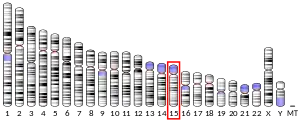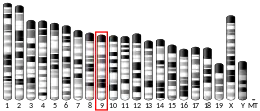DPP8
Dipeptidyl peptidase 8 is an enzyme that in humans is encoded by the DPP8 gene.[5][6]
| DPP8 | |||||||||||||||||||||||||||||||||||||||||||||||||||
|---|---|---|---|---|---|---|---|---|---|---|---|---|---|---|---|---|---|---|---|---|---|---|---|---|---|---|---|---|---|---|---|---|---|---|---|---|---|---|---|---|---|---|---|---|---|---|---|---|---|---|---|
| Identifiers | |||||||||||||||||||||||||||||||||||||||||||||||||||
| Aliases | DPP8, DP8, DPRP1, MSTP141, MST097, MSTP097, MSTP135, DPRP-1, dipeptidyl peptidase 8 | ||||||||||||||||||||||||||||||||||||||||||||||||||
| External IDs | OMIM: 606819 MGI: 1921638 HomoloGene: 57098 GeneCards: DPP8 | ||||||||||||||||||||||||||||||||||||||||||||||||||
| |||||||||||||||||||||||||||||||||||||||||||||||||||
| |||||||||||||||||||||||||||||||||||||||||||||||||||
| |||||||||||||||||||||||||||||||||||||||||||||||||||
| |||||||||||||||||||||||||||||||||||||||||||||||||||
| |||||||||||||||||||||||||||||||||||||||||||||||||||
| Wikidata | |||||||||||||||||||||||||||||||||||||||||||||||||||
| |||||||||||||||||||||||||||||||||||||||||||||||||||
This gene encodes a member of the peptidase S9B family, a small family of dipeptidyl peptidases that are able to cleave peptide substrates at a prolyl bond. The encoded protein shares similarity with Dipeptidyl peptidase-4 in that it is ubiquitously expressed, and hydrolyzes the same substrates. These similarities suggest that, like dipeptidyl peptidase IV, this protein may play a role in T-cell activation and immune function. Alternatively spliced transcript variants encoding different isoforms have been described.[6] A relatively specific inhibitor of DPP8 and DPP9, Val-boroPro [7]-,[8] leads to increased activation of the inflammasome though both NLRBP1 and CARD8 and can trigger pyroptosis.[9]
References
- Notes
- GRCh38: Ensembl release 89: ENSG00000074603 - Ensembl, May 2017
- GRCm38: Ensembl release 89: ENSMUSG00000032393 - Ensembl, May 2017
- "Human PubMed Reference:". National Center for Biotechnology Information, U.S. National Library of Medicine.
- "Mouse PubMed Reference:". National Center for Biotechnology Information, U.S. National Library of Medicine.
- Abbott CA, Yu DM, Woollatt E, Sutherland GR, McCaughan GW, Gorrell MD (Nov 2000). "Cloning, expression and chromosomal localization of a novel human dipeptidyl peptidase (DPP) IV homolog, DPP8". Eur J Biochem. 267 (20): 6140–50. doi:10.1046/j.1432-1327.2000.01617.x. PMID 11012666.
- "Entrez Gene: DPP8 dipeptidyl-peptidase 8".
- "PubChem:Val-boroPro".
- Okondo MC, Rao SD, Taabazuing CY, Chui AJ, Poplawski SE, Johnson DC, Bachovchin DA (March 2018). "Inhibition of Dpp8/9 Activates the Nlrp1b Inflammasome". Cell Chemical Biology. 25 (3): 262–267.e5. doi:10.1016/j.chembiol.2017.12.013. PMC 5856610. PMID 29396289.
- Johnson DC, Taabazuing CY, Okondo MC, Chui AJ, Rao SD, Brown FC, Reed C, Peguero E, de Stanchina E, Kentsis A, Bachovchin DA (August 2018). "DPP8/DPP9 inhibitor-induced pyroptosis for treatment of acute myeloid leukemia". Nature Medicine. 24 (8): 1151–1156. doi:10.1038/s41591-018-0082-y. PMC 6082709. PMID 29967349.
- Further reading
- Strausberg RL, Feingold EA, Grouse LH, et al. (2003). "Generation and initial analysis of more than 15,000 full-length human and mouse cDNA sequences". Proc. Natl. Acad. Sci. U.S.A. 99 (26): 16899–903. Bibcode:2002PNAS...9916899M. doi:10.1073/pnas.242603899. PMC 139241. PMID 12477932.
- Ajami K, Abbott CA, Obradovic M, et al. (2003). "Structural requirements for catalysis, expression, and dimerization in the CD26/DPIV gene family". Biochemistry. 42 (3): 694–701. doi:10.1021/bi026846s. PMID 12534281.
- Qi SY, Riviere PJ, Trojnar J, et al. (2003). "Cloning and characterization of dipeptidyl peptidase 10, a new member of an emerging subgroup of serine proteases". Biochem. J. 373 (Pt 1): 179–89. doi:10.1042/BJ20021914. PMC 1223468. PMID 12662155.
- Ota T, Suzuki Y, Nishikawa T, et al. (2004). "Complete sequencing and characterization of 21,243 full-length human cDNAs". Nat. Genet. 36 (1): 40–5. doi:10.1038/ng1285. PMID 14702039.
- Shu H, Chen S, Bi Q, et al. (2004). "Identification of phosphoproteins and their phosphorylation sites in the WEHI-231 B lymphoma cell line". Mol. Cell. Proteomics. 3 (3): 279–86. doi:10.1074/mcp.D300003-MCP200. PMID 14729942.
- Chen YS, Chien CH, Goparaju CM, et al. (2004). "Purification and characterization of human prolyl dipeptidase DPP8 in Sf9 insect cells". Protein Expr. Purif. 35 (1): 142–6. doi:10.1016/j.pep.2003.12.019. PMID 15039077.
- Gerhard DS, Wagner L, Feingold EA, et al. (2004). "The Status, Quality, and Expansion of the NIH Full-Length cDNA Project: The Mammalian Gene Collection (MGC)". Genome Res. 14 (10B): 2121–7. doi:10.1101/gr.2596504. PMC 528928. PMID 15489334.
- Jiaang WT, Chen YS, Hsu T, et al. (2005). "Novel isoindoline compounds for potent and selective inhibition of prolyl dipeptidase DPP8". Bioorg. Med. Chem. Lett. 15 (3): 687–91. doi:10.1016/j.bmcl.2004.11.023. PMID 15664838.
- Ogasawara W, Tanaka C, Suzuki M, et al. (2005). "Isoforms of dipeptidyl aminopeptidase IV from Pseudomonas sp. WO24: role of the signal sequence and overexpression in Escherichia coli". Protein Expr. Purif. 41 (2): 241–51. doi:10.1016/j.pep.2004.10.027. PMID 15866709.
- Kimura K, Wakamatsu A, Suzuki Y, et al. (2006). "Diversification of transcriptional modulation: Large-scale identification and characterization of putative alternative promoters of human genes". Genome Res. 16 (1): 55–65. doi:10.1101/gr.4039406. PMC 1356129. PMID 16344560.
- Yu DM, Wang XM, Ajami K, et al. (2006). "DP8 and DP9 have Extra-Enzymatic Roles in Cell Adhesion, Migration and Apoptosis". Dipeptidyl Aminopeptidases. Advances in Experimental Medicine and Biology. Vol. 575. pp. 63–72. doi:10.1007/0-387-32824-6_7. ISBN 978-0-387-29058-4. PMID 16700509.
- Yu DM, Wang XM, McCaughan GW, Gorrell MD (2006). "Extraenzymatic functions of the dipeptidyl peptidase IV-related proteins DP8 and DP9 in cell adhesion, migration and apoptosis". FEBS J. 273 (11): 2447–60. doi:10.1111/j.1742-4658.2006.05253.x. PMID 16704418.
- Lee HJ, Chen YS, Chou CY, et al. (2007). "Investigation of the dimer interface and substrate specificity of prolyl dipeptidase DPP8". J. Biol. Chem. 281 (50): 38653–62. doi:10.1074/jbc.M603895200. PMID 17040910.




